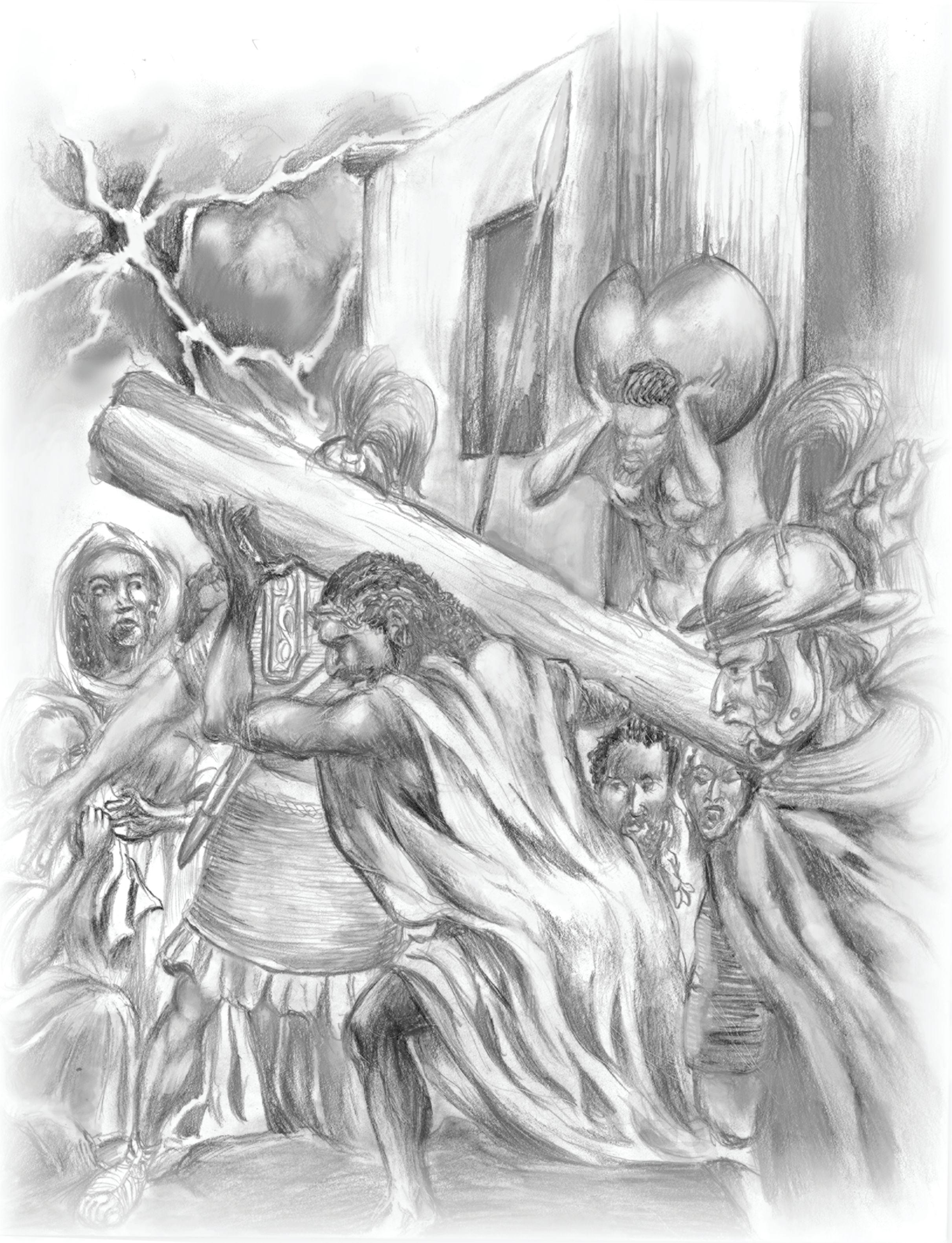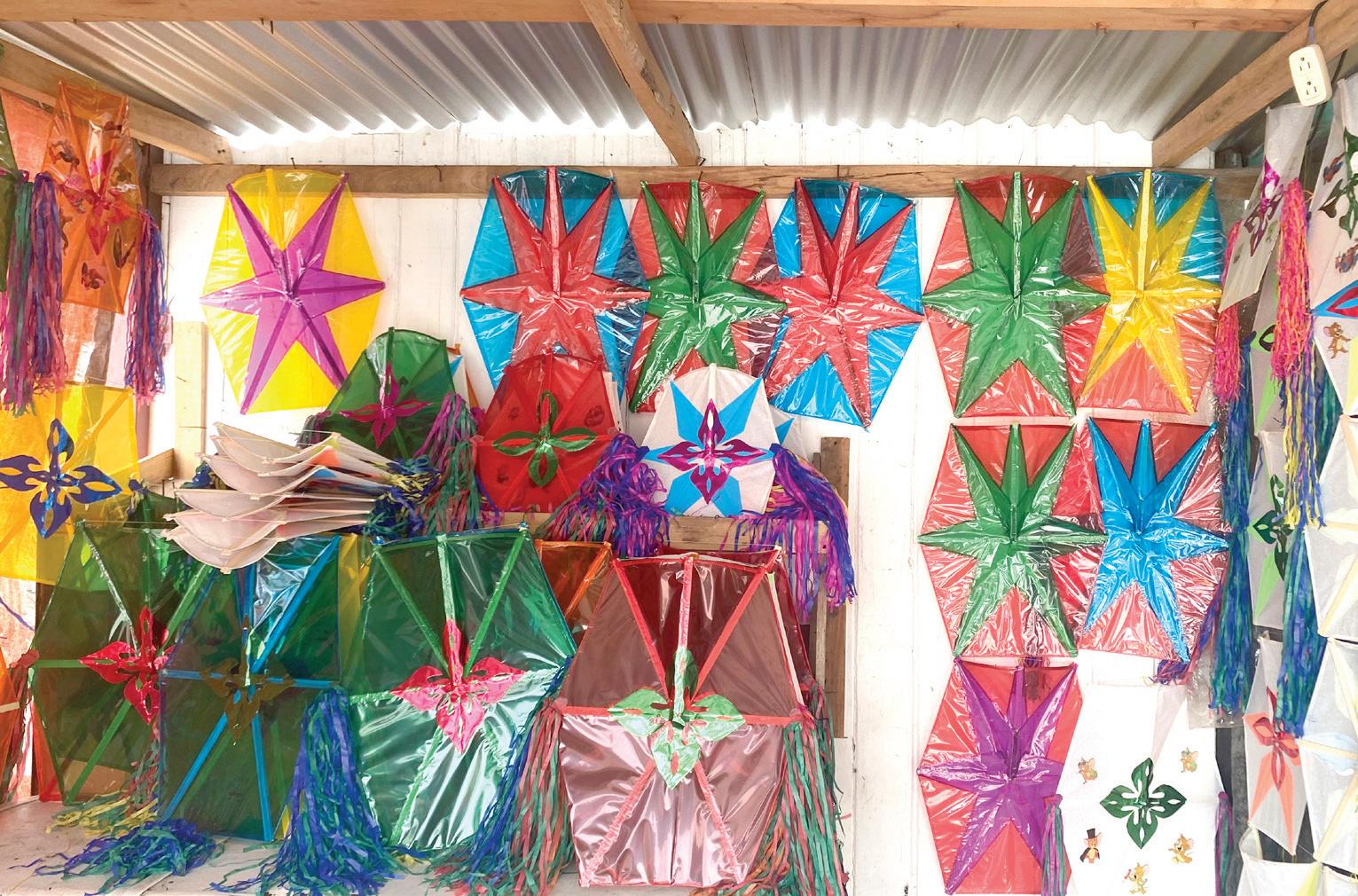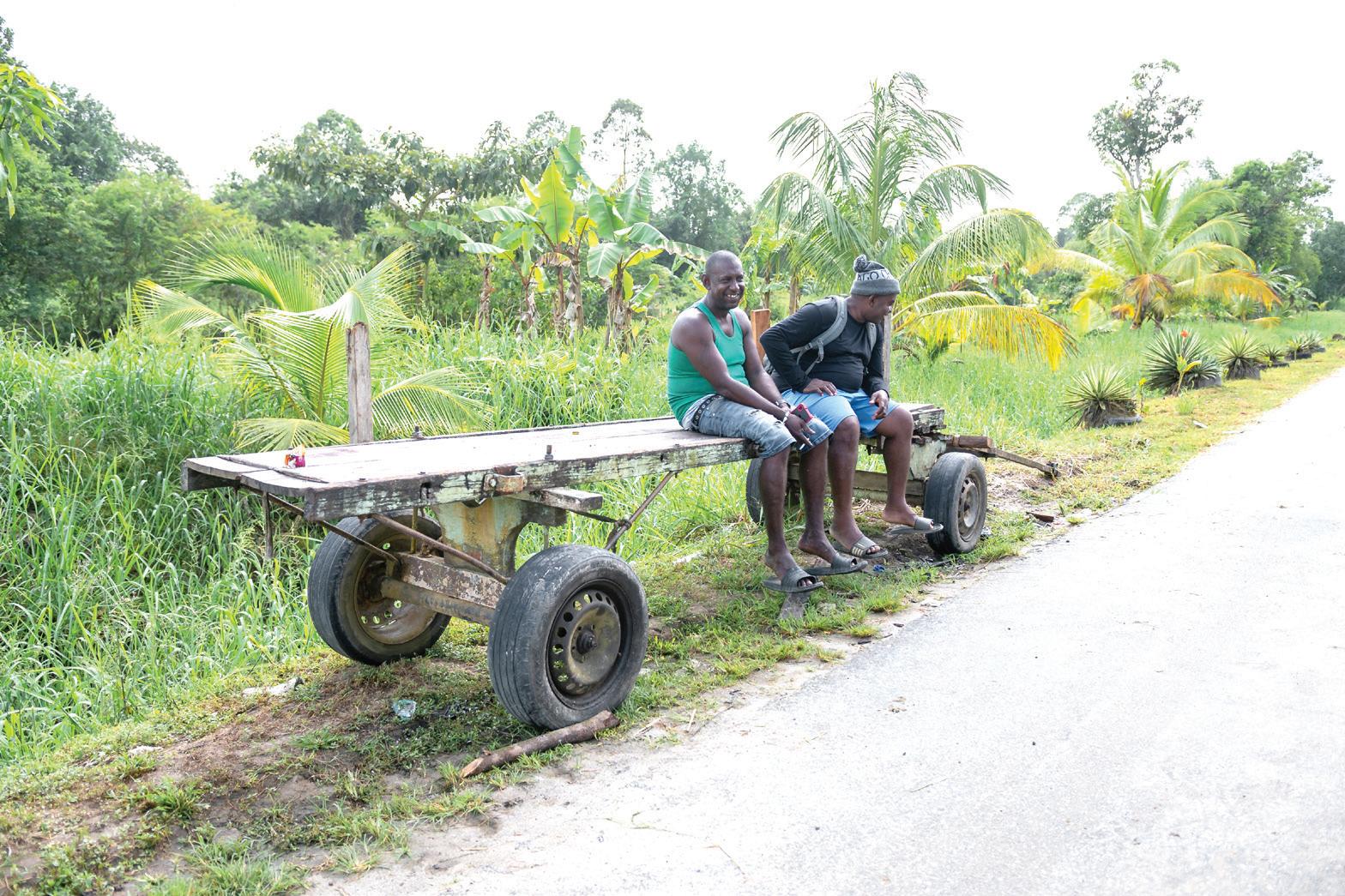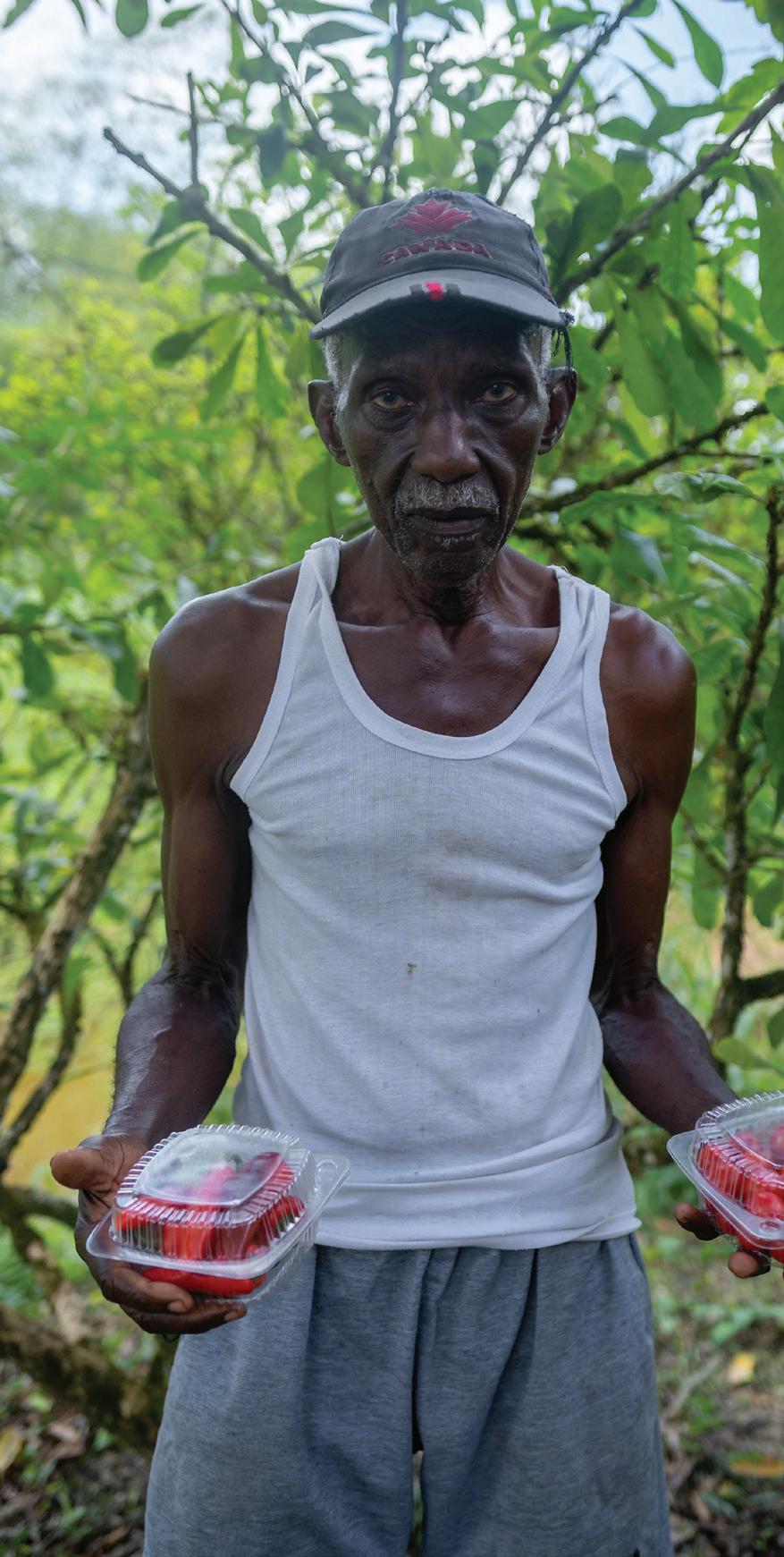Easter Greetings!

















WHAT is Easter without the sweet smell of hot cross buns emanating from kitchens across the nation? What is a Guyanese Easter without families flocking the Georgetown seawall looking for a spot with sufficient breeze to “raise” their kites?
With Easter upon us, Guyanese people are anxious to resume the activities that the infamous corona virus had disrupted.
It is one of the most significant holidays in the Christian calendar. It celebrates Jesus rising from the dead three days after he was crucified.
As one walks down Camp Street and sees the assortment of kites on display, we must
thank our local kite-makers for preserving the craft.
This year, the Pepperpot Magazine visited Region Three, to see how the ‘West Side’ does kite- making.
Despite being a male-dominated field, this publication discovered women thriving and leading the way with precision and creativity. In fact, as soon as you hit the Vreeden-Hoop junction, an array of multi-coloured kites of all sizes catches your eye before anything else.
For Carlotta Peters, the Easter holiday is more than just a time to market kites or turn a profit.
This Crane Village resident, who has been selling
kites for more than 20 years, shared with this publication that she and her husband have been working together to create and sell kites at different locations along the West Coast.
Peters continued, saying that she gradually developed a love for the craft, found fulfilment in it, and now treasures it more than ever.
In addition, she got to spend time with her sister, Joanna Payne, and brother, Joshua Payne, as they playfully chatted with her at the booth while greeting customers.
The Crane Village resident noted that she is thankful for everything because the fear-filled atmosphere of the
pandemic prevented this kind of enjoyment for many.
While it is well known that the corona virus had disrupted various activities, Peters provided additional details on how it slowed down her kite-making, since demands were few. Even though many people were unable to go out in public to enjoy a true Guyanese Easter, she would make special

orders for those who wanted to fly kites in their backyards with their families.
Despite the fact that Peters is very modest about her trade, the sheer number of years that she has been in the industry shows she is an expert.
Who would not want a kite that was carefully and authentically made? How often have you been to the
Georgetown Seawall and witnessed individuals battling to raise their kites? A kite is made to fly, so it needs to be treated like a piece of art. Whether the tail is too long or short, the loop is not set properly, or the kite is poorly designed are signs of a kite that was simply not made
Throughout our local history, millinery (hat-making) has played a major role in many Guyanese lives and though it may seem like the art is dying, there are still some prominent hat-makers that are working to keep the craft alive and well.
While some might believe that age makes us mature, local hat-maker Fazal Mohamed contends that maturity is about undertaking responsibilities.

With encouragement
Malgre Tout primary school when his mom became a single parent. Fazal Mohamed did whatever it took to support his mother and five siblings, despite the odds being stacked against him. He even asserted that he was by his mother’s side right up until she recently passed away.
The Best Village, West Coast Demerara resident told the Pepperpot Magazine that despite having many interests and talents, hat-making is the art that he has fallen in love with.

Speaking to this newspa-
calling, he first worked as a labourer and did carpentry work wherever it was possible before learning how to turn hat-making into a trade. Mohamed noted that the craft had been in his family for many years, but he said he had made a few modifications to better the art and serve his clientele.
Although women dominate in the hat-making industry, Mohamed has been in the business for over fifty years and has never felt threatened by competition. This Plantain Walk resident is conquering
to supporting one another’s interests. His wife, who is fond of painting, stated in an invited comment with this newspaper that she has contributed her skills to his craft throughout the years.
Although he had already started his millinery career, the fact that he was a husband and a father of three spurred him to work even harder and owing to this dedication he had been able to put all three of his children through school, all up to tertiary level, thanks to his tenacity and hard work.
In addition, he recalls drawing influence from the hats he made for his three sons and now his grandchildren.
Staying Humble
of his charitable actions, Mohamed’s neighbours have
makes hats, but he also excels in cooking. When asked if he likes cooking over hat-making, he laughed, saying nothing can compare to millinery.
The Plantain Walk resident, who began cooking at age215, said, “cooking comes second because I love making hats.” He further stated that a plate of hot food is always there for anyone in need, regardless of the occasion.
According to Mohamed’s family, even passers-by can obtain produce from his garden, which includes dates, grapes, lychees, and pepper, to name a few.
He further provided a tour of the kitchen garden, bursting at the seams with local and exotic fruits.
According to his family, gardening is another activity Mohamed picked up and mastered independently. When Fazal is not listening
from that simple phrase, 67-year-old Mohamed has been able to persevere.
For Mohamed, it did not matter that he was just a 7-year-old boy living in Vreed-en-Hoop and attending
per, he claimed that he felt neither regret nor pressure from the duty; rather, he claimed that “it was what I had to do.”
Mohamed also added that before discovering his true
millinery head-on, propelled by his creative flair and the support of his family.
Akeela Mohamed and Fazal, who have been married for about forty-two years, have been devoted

“Be the change in the world you want to see in the world”. Many of us complain about the state of homelessness and poverty but how many of us are actually giving?
For Fazal Mohamed, giving to those in need is not an obligation but a blessing and source of joy. Because
referred to him as the “foundation” or “root” of the community.

Moreover, he not only
to his vintage vinyl record collection, you can find him working in his garden or caring for his beloved rabbits.
“It was more solemn.”,“It was more quiet.”, “There was more reverence, commitment and significance.” Those were just some of the sentiments used to describe what Easter was like some 40 or 50 years ago. Easter is widely celebratedat this time of year, and opinions on its traditions over the years differ greatly from person to person.
Easter eggs. Going on, he made clear his belief that modern-day traditions have done alot to obscure Easter and its significance. As pastor Caines spoke fondly of the earlier days ofEaster, he wishes persons today would reconnect with the older Easter traditions.

When asked about the religious significance of Easter to him as a pastor, he stated that Easter is not just about Jesus’ resurrection, but it also celebrates his life and sacrifice. “ The death, burial and resurrection of Jesus Christ [are] the capstone of the Christian faith,” he said. Pastor Caines and many other pastors, preachers and apostles in Guyana are planning a day ofAtonement. This year it was scheduled to be at the VreedEn Hoop Tarmac at 15:00hrs on April 7 (Good Friday). Pastor Cainesdescribed the occasion as an attempt to recapture the religious significance of Easter and what it means:family, fun and Christ’s sacrifiice.
The significance remains
Being in the ministry for more than 15 years and holding the title of Apostle, is Gregory Dubissette. He is the head of Jesus Restoreth Ministries, which has abranch located at Parafait Harmonie on the West Bank of Demerara. To him, Easter is simply about the life, death, and resurrection of Jesus Christ, saying that, “If Jesus hadn’t died, we wouldn’t be celebrating Easter.”


Easter. He stated that the message is simple:“Jesus came to die for sinners, and my focus will always remain on that.”
The story of Easter is a well-known one, but few know it as well as Christian leaders. The Pepperpot Magazine interviewed three local Christian leaders who have seen Easter over a different number of years and sharedtheir different points of view.
There are few who can better speak about the changes the Easter celebrations have seen more than someone who has been a pastor for over 35 years. Pastor Foster Caines has seen Easter unfold in his church, Shekinah Worship Center, located in GoedFotuin on the West Bank Demarara.
The vivid description of Easter by Pastor Caines sounds more like a dreary village rather than a town celebrating Easter. He spoke of Good Friday as being a day when shops closed, activities ceased and everybody went to church. “ Long ago, you could’ve felt it was Good Friday,” the pastor recalled. However, kite flying was still a big part of Easter in his childhood. He recounted how much he enjoyed kite making, kite flying, and crossbuns. He said that previously, the occasion of Easter held more reverence, commitment and significance.
When asked about what Easter means to him, Pastor Caines stated, “Easter, to me, now, is indicative of the new life God has given to us,” he stated. He also believes that Easter has changed a whole lot throughout the years. And although things such as Easter bunnies and Easter eggs existed then, they were not as widely enjoyed as they are today.
Pastor Caines stated that previously, one had to be of a “certain status in society”to enjoy such things as
In the present day, and from a Christian perspective, Apostle Dubissette believes that the true meaning of Easter has and always will be the same.“ If I was speaking today or in the 1900s, the message remains the same: Jesus died for us and we celebrate his resurrection,”said the Apostle. Although aspiritual man, ApostleDubissette too, recounted his childhood Easter days filled with kites and games on Easter Sunday. These same memories lead him to believe that most modern traditions are fine just the way they are. His opinion on traditions such as Easter eggs, however, differs. He believes that customs like or relating to Easter bunnies are substitutes, trying to distract from Easter’s significance. “If people focus on Easter bunnies, they will take their minds off what Easter is about,” he said. He went on to say that some modern-day celebrations are simplydistractions, trying to move something as highly religious as Easter into a ‘secular world.’ As much as these modern customs are known, the church leader firmly holds that they will not completely overshadow the true importance of
A fresh and interesting take on Easter came from Pastor Timothy Squires. At just 30 years old and being an ordained pastor for a little over a year, he gives a very simple view of Easter in Christianity. He defines Easter as “the holy week”. To Pastor Squires, Easter is more than just Easter Sunday; but rather begins on Palm Sunday the previous week and includes Good Friday.
He stated that people walk with the leaves of palm trees upright to remember how people threw palms on the ground for Jesus to walk on. Although now, as a religious leader, he understands the significance of Easter, he admits that Easter was simply about the kites and fun as a child. But as he grew older, he now understands the true meaning of Easter. He said that, as a child, “The only thing at the back of my head was that ‘Easter is coming and I need a kite’,” he recalled, “But as I grew in God, in the faith, I understand what Easter is all about.”
When asked about the changes in Easter celebrations, he admitted that Easter has changed over the years. But how he describes these changes may not be what you expect. Pastor Timothy believes that the difference lies in that, today, the gospel of Easter reaches further than ever. Additionally, he believes that modern traditions take nothing away from the religious value of Easter to Christianity. “All that matters is that the true meaning of Easter is known, understood and celebrated,” he explained. PastorSquires’s message from Easter that he applies to the real world is simply love.
All these opinions and thoughts vary in some way or another, but some ideas remain the same. They can all agree on what Easter is ideally about.It celebrates the sacrifice made by Jesus some 2000 years ago. How this sacrifice is celebrated has shifted over the centuries and changes from one generation to the next.
And although ideas may differ, change and might never be the same, the world celebrates Easter together. This time is about reuniting and re-establishing the privileged relationship mankind has enjoyed with God.

LAST week the Pepperpot
Magazine visited Cuffy Dam, Friendship Village, East Bank Demerara to
highlight the way of life of the locals. The community is

The main access road, once a mud dam, was paved to an all-weather road in 2018, which significantly enhanced the lives of the locals and is about two and a half miles long.

Cuffy Dam, Friendship Village, is a large community with fertile soil composition, but this area is often flooded due to the lack of drainage and irrigation.


As such, farmers have to plant their crops in buckets and other things instead of cultivating directly into the soil.
There are dwelling houses only on one side of the village and it is basically a lot of farmlands managed by a land cooperative society.
close-knit and consists of like-minded residents lead a very simple way of life by mostly farming and doing other jobs outside the village to earn.

Friendship Village is bordered by Garden of Eden and New Hope communities. It is a village that is set deep within the backlands area.

In giving a historical background, villager and elder, Fitzroy Valentine,better known as Uncle Val,told

AT the start of Cuffy Dam, Friendship, East Bank Demerara, there is the home of Kevin Nedd, who lives just as you enter the village.

The father of one is a horse-drawn cart operator, a construction worker and also a farmer.
He has a plot of farmland aback the community and he has only a crop of coconut trees, due to the constant flooding in the village.
Nedd told the Pepperpot Magazine that he could not work that day because his newly acquired horse had an injury, so he had to allow the animal to heal before he can return to work at the lumberyard.

The local added that Cuffy Dam is a good place to live; it is the peace he appreciates a lot and the people are close-knit with little or no time to idle and cause trouble.
Nedd stated that most people are farmers, while others have jobs outside the village, consisting of East Indians, Afro-Guyanese, some Amerindians and a handful of Spanish people.

He pointed out that the Marfriends’ Co-operative Land Society is responsible for the farmers and they have a building and a body of members who reside in the village.
“I have a simple mantra that works for me, and it is ‘work, save and economise’,” he said.
Lauren SinclairLauren Sinclair lives way down in the backlands section where there are both houses and farms.
The 34-year-old told the Pepperpot Magazine that she is a stay-at-home mother of four children and she is expecting her fifth child and does the chores, including cooking, as well as tending to the children.
Sinclair’s house is a
wooden cottage with plenty of yard space on the side of a muddy dam, where there is no road and it takes a bit of walking to get there.
She reported that her daughter walked out to the public road that morning, it took her half an hour and she was unable to get any public transportation; as such, she was forced to return home.
The resident of Cuffy Dam reported that she is from the city and was residing with an uncle who has



mental issues; living in the same house with him became traumatic and she had to relocate.
She was allocated a plot of land and she began living there about five years ago to escape paying rent.
“It is far, but this place is nice and quiet and there are
SEE PAGE XIV
his
 By Michel Outridge
By Michel Outridge
JADE Hudson is perhaps the oldest resident of Cuffy Dam, Friendship, East Bank Demerara. She is a very friendly person with a bubbly personality and the spirit of a teenager.
The 87-year-old told the Pepperpot Magazine that she has been living in the village since 2001 and she occupies the home of her sister, Yvonne Williams, one of the founding members of the coop society who passed away three years ago.
Hudson is originally from Aruka River, North West District, Region One (Barima-Waini), but was living in Berbice before she moved to Cuffy Dam.
challenging for her to fully use that hand.
Hudson related that these days her house is filled with her adopted grandchildren and her grandson and his girlfriend, who would assist her with the cooking and chores.
She stated that she had two sons, but both have since passed away, and she is separated from her husband, but they still maintained good relations over the years and he would often visit when he is not working.
Hudson has seven adopted grandchildren and four great-grandchildren.
The elder explained that she spent many years in the interior with her husband, a prospector.
She recalled when she
stopped visiting the hinterland about 30 years ago and she basically resided in the city mostly. She feels really at home in Cuffy Dam surrounded by people, family and friends.
“I like to do things for myself, so not being able to cook and clean is quite a bother for me, but I does still use one hand to make my own coffee in the morning which is one of the little things I enjoy doing for myself,” she said.
Hudson is a one-of-akind person, so full of life and always smiling and she seems contented with life and what it has to offer.
ducks.
Stoll added that her husband began farming in Cuffy Dam in 1993 and they moved in the village in 1994 and lived in a small wooden cottage that was flooded in 2005.


She stated that she is from Moruca, but grew up in Alexander Village. Her parents were farming on Hogg Island, Essequibo River.
Stoll is the mother of two and has an adopted child. Collectively, they operate a farm and a poultry business from their home.
She explained that they operate the hatchery, sell ducks and ducklings, that is, herself and son, while
her husband has his farm.
Stoll reported that they used to rear pigs and sheep, but stopped because of challenges and also reared some boiler chickens and sold eggs in the past.
The elder added that they were planting cherries on a large scale and used to supply Topco with cherries to make local fruit juice, but they had to quit because they were not getting workers to pick the cherries.
Stoll explained that they constructed a shadehouse and began growing many vegetables, fruits, seasonings and coconuts.
“I don’t buy greens, seasonings or fruits, because everything that is needed for

the kitchen we grow and it is organic and wholesome,” she said.
These days, crops are sold to a wholesale buyer who would visit when they harvest and do not go to markets to sell produce.
Stoll used to sell plucked chickens and eggs, which she took to the city, but stopped because of challenges.
“After the major flood in 2005, we haven’t had any such since and we cultivate one hectare of land and we have different sections for our ducks and hatchery. I like it here because it is very tranquil and there is space to do things to earn right from home,” she said.
Things were going well for the elderly villager in terms of taking care of herself, doing her own cooking and cleaning. Until February 10, this year, she was holding a rake in the yard about to pile up some fallen leaves when she reportedly fell. She received an injury to the hand and it has since been
first moved: the village was a mud dam, a track leading into the village and they had no facilities.
Hudson said it was until 2008 they had an upgrade in the road and they benefitted from electricity, potable water and landline phones with internet.
Hudson reported that she
Also in the same village is the home of Rajpattie Stoll, a poultry farmer who is well-respected in the community.
The 63-year-old told the Pepperpot Magazine that herself, husband, Rudolph, 68 and her son have a farm and a hatchery with Muscovy
 By Michel Outridge
By Michel Outridge
TERENCE Walters, an elderly farmer of Cuffy Dam, Friendship, East Bank Demerara related that his village is a quiet, breezy and peaceful place to reside.





He reported that apart from flooding which often destroys crops, the villagers have no major issues. He is among one of the early settlers in the village but added that when he moved in the community, a handful of people was already there.
The 65-year-old told the Pepperpot Magazine that it was 26 years ago he settled in Cuffy Dam, Friendship, and it was a mud dam with little to no infrastructure.
He disclosed that Marfriends’ Land Coop Society manages the farmlands and comprises members, all of whom reside in the village.
Walters said they have an office building right in the same community for which meetings are held to discuss co-op affairs.
He is a full-time farmer who lives alone in his wooden cottage and from time to
time, he would go for a vacation abroad to spend time with his children and wife.
“The back low and the front of the land is high, so you have to decide where to plant and what to grow here because the flooding is often and it would destroy all the crops. Only the plantain and banana survived and a few coconut trees,” he said.
The villager reported that each resident was given two acres of land to farm and the soil is very fertile. Almost anything grows there but it is just the floods that are worrisome and deterring quality food production.
Walters added that he is originally from West Coast Berbice but Cuffy Dam is his home.
IN giving a historical background of the village, Fitzroy Valentine, a farmer and resident of Cuffy Dam, Friendship, East Bank Demerara, recalled that after the farmer’s co-op was established, all produce had to be taken to the co-op, which provided all the inputs for cultivation.
The farmer, he said, would be given half the value of the crops in cash and after the co-op extracted for other costs, the rest of the money would go towards the shares. The farmer then decides if he wants the rest of the cash or to sell the remainder of his produce.
Valentine told the Pepperpot Magazine that over time, some farm-

ers made a new track out of the village without showing up with their produce at the coop and after Pastor Herman Craig passed away, the co-op somewhat fell apart and was functioning halfway.
The elder stated that before Pastor Herman’s passing he had applied for a loan of $500,000 from the then-Guyana Agricultural Bank. The money was available for infrastructural development within Cuffy Dam via the co-op.
The money was, however, used to dig trenches, drains, canals and build dams to boost the drainage and irrigation integrity of the community to promote farming, he said.
Valentine reported that for the dying co-op to remain in operation, Co-op Officer Morris Edghill visited the village and recommended that the marketing/producers co-op society be changed to a land co-op.

This move, the farmer stressed, was necessary, because the village and farmers will benefit from both input and output and will just have to pay dues, so the Cuffy Dam Land Co-op Society was formed in 1992.
Valentine reported that after that the then Head of State Hugh Desmond Hoyte visited and started to sell portions of the land into a divestment term to a company and only two parcels were sold.
He explained that many farmers occupied the land during that time and they started to get a lot of flooding due to the public road being very low and the water accumulated quickly, since that area was once a reservoir for the catchment from Craig to Relief.
Valentine added that flooding has been a problem in that area for a long time, due to a lack of drainage and irrigation.
But when the team visited they observed a hymac and other heavy-duty equipment upgrading the canals that run adjacent to the village.
“Despite the flooding, this land is very fertile because of its soil composition, which includes pagasse and clay, but right now the land is sour from the recent flooding. But when we have good weather that promotes growth, even a dead man will grow here,” he said.
The soil is best suited for citrus, roots and tubers.
Valentine’s has a cultivation of cherry tomatoes, sweet peppers, mustard and kale, which he packages in plastic containers for sale.
The 73-year-old told the Pepperpot Magazine that he would walk and sell his produce on Water Street, the Vendor’s

Arcade and Regent Street and on weekends, he would go to La Penitence Market.
Valentine’s brand is “Kitchen Support” and his produce are organic and wholesome, but his cherry tomatoes are his pride and joy.

The farmer is very passionate about what he does, knowledgeable about cultivation of crops, and looks at things from a scientific point of view.
He has been a part of many farming programmes and also worked with many volunteers, from whom he gained much insight into producing crops faster than normal, due to several implementations.

Valentine gained the technical know-how and he would harvest pak choi every three weeks instead of waiting for several weeks.
The farmer explained that his first wooden Green House collapsed one day without warning. After considering certain factors, he invested in galvanized pipes to make frames for his crops and incorporated that into his new Green House, which has not failed him since.


Valentine stated that because of the training he received, he is equipped with the relevant knowledge to harvest faster and is getting better crops, which is also organic.
For instance, he explained that pruning trees is also essential and when doing so, you can leave five to seven branches if it is a cherry tree; and if you get one five gallons of cherries from it, the other trees, when pruned, would also give the same amount.
Valentine has about 64 cherry trees and when it is time to harvest, he would have to employ people to assist him with picking the cherries.
THE EPA must take a number of steps to control pollution, including conducting investigations and inspections to ensure compliance with the Environmental Protection Act and Regulations and providing information and ed-

ucation to the public regarding the needs for and methods of protection of the environment. In collaboration with the Communications Department and Legal Unit, the dedicated Complaints Unit oversees the complaints

management process by ensuring that the functions listed above are executed.
The nature of complaints the EPA receives encompasses every sector and scale, from manufacturing to mining. Most complaints are related to noise, air (fumes, odour) and solid waste management and occur mostly on Guyana’s coast in Regions Two, Three, Four and Six. These instances of pollution usually stem from small operations such as furniture manufacturing, mechanic and auto-body shops, animal rearing, and dumping of household waste.
Standard Operating Procedure for complaints management
You, too can assist the agency. Members of the public can report environmental complaints utilising any of the following methods:
? Complaints 24-hour hotline number: 592-225-5469; or

? E-mail: complaint@epaguyana.org.
Please note, complaint reports MUST include:
i. Nature of the complaint;
ii. Name and address of business/entity/person causing the pollution;
iii. Name of the complainant (person making the complaint); and
iv. Contact information and address of the complainant. You can also message us on Facebook. Complaints can also be made to our regional offices in Whim, Berbice and McKenzie, Linden:
1. Whim Office – 337-2201; and
2. Linden Office – 444-2313.
Enforcement actions
The EPA makes every effort to work with operators to ensure that their business causes little to no environmental damage; however, there are some instances where hard enforcement becomes necessary.
* Warning Letter
* Enforcement Notice
* Prohibition Notice
* Cease Order
* Prosecution
Remember, your first line of action should be to contact your local government authority (Regional Democratic Council/Neighbourhood Democratic Council) on the matter. Please be assured the Agency will treat all information received from the public with the strictest confidence. Complainants, however, should be willing to attend court and testify should the matter require legal action.
You can share your ideas and questions by sending letters to: “Our Earth, Our Environment”, C/O Communications, Environmental Protection Agency, Ganges Street, Sophia, Georgetown, or email us at: eit.epaguyana@gmail. com. Follow us on Facebook and Instagram and subscribe to our YouTube channel.
ONE of the things I thoroughly enjoy is visiting schools and interacting with our future leaders. We must continue investing in them and empowering them to give the world the best version of themselves. When young people have exposure to inspiring ideas and opportunities and the tools to build their faith and confidence muscles, they think sizes bigger and achieve great things. An empowered young person recognises that intentional focus is necessary to move to the next level, also their capabilities, self-determination and worth. They feel comfortable trying new things and prefer to try and fail,
Disadvantages - High cost of living, crowded cities
Advantages- Vibrant cul -

rather than fail to try.
I have met many past students as young adults and adults, and it warms my heart to hear their stories.
When I was in Cape Town, South Africa, I received an FB message from Antonio London reminding me of my visits to Tutorial High School when he was a student there, and he how would love to meet with me if I am passing through to ‘Joburg.’ Fortunately, ‘Joburg’ was on my itinerary. I was scheduled to be on a panel at the Village Foundation and I invited him to attend and he accepted. Antonio and his wife took me to dinner and we had some amazing discussions. We even had the opportunity to browse through the mall featuring the Nelson Mandela statue, one of my favourite historical figures.

I was intrigued that this young man has lived on so many continents and is still so young. Also, leaving the United States to live on the continent of Africa was quite admirable. I admire his intentionality and conviction and decided to ask him a few questions. He shared his answers as outlined below:
Three words to describe myself - curious, empathetic, analytical.
What I’m most proud of : I’m proud of my ability to adapt to new situations and challenges and my willingness to learn from my failures and mistakes.

Advantages and disadvantages of each continent: Europe
Advantages - Rich history and culture, well-developed
FROM PAGE VII no nosy neighbours and people around here don’t have time for nonsense,” she said.
Sinclair pointed out that they used to farm, but floodwaters destroyed most of their crops and her husband works in the city and he would do the shopping and bring it home.
She recalled the day she moved into the village; it was Old Year’s Day in 2018 and things have been fair since.

Bryan Itwaru, the construction worker
About halfway down Cuffy Dam is the home of Bryan Itwaru, who was in the process of completing the cement floor of his mother’s new house that is being built in the same yard.



The 24-year-old told the Pepperpot Magazine that he has been residing in the village for the past 20 years and has two siblings and his cousins living next door.
He reported that his mom is a policewoman and his dad is away at work.
“This is a nice place to live, no rowdy people, just simple living and it is breezy and quiet all the time,” he said.
Itwaru disclosed that in that section of the village, they have potable water supply but no electricity and they use a small solar system to power light bulbs, but they do have landline phones, but no internet service.

The death and resurrection of the ‘Christ’ is described as “The Greatest Story ever told”.It revolves around the exploits of a young man who inspired millions. But his name has been twisted by organised religion and cults, to commence murder, theftand deceptions into physical and mental bondage of millions because he became enveloped as arevolutionary religious personality, to which he paid the ultimate sacrifice.


One of the most interesting episodes of the records of Jesus the man, whom the ancient people of Khemet would deem the maa Kheru and Christendom ‘the Christ’ rests with the incidents surrounding theevent that envelopes Gethsemane. From the narratives in the New Testament, Jesus knew that he had made enemies with the local class structure, who were as vicious as ever to protect their comfort zone even though pagan imperial Rome had colonised their sphere of operations.
What class structure are we discussing? Together, the Scribes and the Pharisees constituted the legal and social policing of their population. Kind of today’s lawyers and then, social moderators of immense authority, in that order. Christ had a perspective on the Pharisees, that is still haunting the legal profession today, “Beware of the Scribes,whichlove to go in long clothing, and love salutations in the market places; and the chief seats in the synagogues, and the utmost rooms at feasts: Which devour widows’ houses, and for a pretense make long prayers: these shall receive greater damnation.” –Mark 12-38.
Thus, Jesus became more than just another sect proselytiser, but rather one who
was construed to be an appointed deliverer ordained by Godthrough the faith he departed to the obviously hopelessly occupied population. He had become a troublemaker to the beneficiaries of then-organised religion. He had become too great an influence not to pay attention to.
The conspiracy against Jesus did not come from the Romans but from the very Jewish religious oligarchy‘becausenothing severe had changed for them despite Roman rule.’ One of the most revolutionaryinsights from Jesus on the relationship between man and the divine is: “God cometh not with observation. Neither shall they say, Lo here, or there! For, behold, the Kingdom of God is within you.” – Luke, chap. 17 verses 20-21.This was in response to his taunting interrogation from the Pharisees, who had asked when would theKingdom of God come. This telling narrative must have brought anger to that section of the religious hierarchy who had held their flock within a realm of subtle superstitions
and he that hath no sword, let him sell his garment and buy one.” Was there a swift consideration to defy those who pursued him? Even If,theywere successful in escaping the charge of him declaring himself ‘The Messiah’,which was punishable by death, if in defense they possibly could have been successful, then what? Escape to somewhere beyond the Roman rule? Jesus was raised in Khemet (Egypt) but they had long lost their inde -
pendence. His only other familiar options would have been Kush (Sudan) or Punt (Ethiopia) a far stretch, but in doing that, the Scribes and Pharisees would undo his teachings, rewrite his legacy and damn him. This was common then and afterwards with those peoples and lands that the Rabbis thought to be foes. For this Jesus (yes, there were others) was tremendously popular among the ordinary people. This Jesus of Nazareth, son of Miriam. Jesus
would have known that the religious authorities would stop at no bribery of hecklers, soldiers and thugs, towards his crucifixion, yet, he embraced his faith. Thus, we should explore the heroic stand he took, and the narratives ascribed to him, that can be translated to other human platforms. We can doubt the following that constitutes the Easter pageant when it comes to the resurrection. But we will also quietly confess that we just really do not know.
about themselves as God’s angels on earth, with infinite access to the kingdom of God rather than as collaborative religious counsellors. It also would have sent a sense of nervousness to all those told this, because it ushered into the active consciousness the issue of personal responsibility, in one’s dealings with the decisions we make regarding principles and values. It erodes the common comfort zone of, “tek a treacherous chance, then beg God fuh, forgiveness.” Jesus had shifted the confession concept to more of a personal responsibility, through which redemption may only be realistic through one’s own commitment to a more stable state of principles and values, towards eclipsing what we describe to console our misgivings as- “the way of the world”.
Upon realising that his preaching’s had offended very powerful people with the means to harm him, he most likely considered the following option “But now, he that hath a purse, let him take it, and likewise his script:
THAT story it seemed had already been written and set into play by fate, the master storywriter, drawing her into the father’s and son’s lives.
Marissa, though, had her doubts of anything happening between her and Aditya other than being friends.
“You can’t know that!” Cindy voiced strongly.
“I have seen close up the grief he is still battling with and the concern for his son’s wellbeing,” Marissa explained to her colleagues.
“Well, that’s how it began,” Shivanie stated, “and the story continues.”
Marissa shook her head in mock exasperation, knowing she couldn’t dissuade the two of them from how they were seeing things. She knew he felt this appreciation and blissful relief because his son had found warm comfort with her being his teacher.
“And that’s the role I’ll play in his young life unless something changes.”
Aditya went back to his mining businesses and said to her that morning as he left her classroom, “I’ll be gone for two weeks.”
She sent him regular updates on Aryan, noting he was doing fine except for a few moments during the day, a fleeting sad look in his eyes.
“He’s missing you,” she told him, “but he’s being a brave boy now.”
“I know and I’m very happy he’s learning to cope,” he replied.

He asked her how she was doing and confessed, “You know I actually miss talking to you at school. It somehow add some enthusiasm in my day that before had been somewhat dull.”
“I’m happy to have helped in some way.”

“You have, guess I needed true kindness and compassion in my life after you know…”
He left the sentence unfinished because of the pain she knew he felt every time he mentioned his wife’s death.
One morning as she was marking the register, noting Aryan hadn’t come to school, his grandmother came in with him. It was the first time she had brought him to school and she apologised, “Sorry for being late, he didn’t sleep well last night, was quite restless.”
“Ooh,” she expressed to the child with concern, “Are you okay, now?”
He nodded and she put her arm gently on his shoulder, saying in a gentle tone, “You can take your seat.”
He moved closer to her instead and buried his face in her bosom as though seeking comfort. That took Marissa by surprise a little though she knew, the desire for comfort was a norm for little children. For Aryan it was deeper.
She noticed the displeased look that flashed across the grandmother’s face and she motioned to her to sit as she settled the child at his desk.
“Why was he restless?” she asked her.
“It’s how it’s been since his mother died, though we’ve been trying to give as much comfort and care as we can.”
Marissa sighed, looking at the child, “I guess it will take some time.”
The grandmother sighed also, shaking her head a little exasperated, “It’s been really tough on everyone.”
She left abruptly and Marissa thought, “She seems a bit upset but I guess the situation she is in isn’t easy.”
Aditya came back after two weeks and on his first morning at school with Aryan, he said to Marissa, “As promised, not a day late.”
“That’s good.”
“And…” he paused and said with a casual smile, “It’s nice seeing you.”
Words that add to the new feeling within her for she was happy to see him too.
He did not bring Aryan to school every day, busy on a new project but they spoke regularly for short periods on the phone. He came by on Friday, but she had been called into a meeting with the headmistress whilst another teacher held her class. So he left a note for her inviting her out for dinner on Saturday night at Bistro. She was uncertain but accepted when he told her, “It’s unofficial, just a way to say ‘thank you’.”
He wanted to pick her up but she politely declined and when she got there, he was waiting at a reserved table with a bottle of wine chilling.
“Nice,” she remarked.
He was dressed in classy casual wear and confidence in his smile as she inwardly battled a nervousness, given it was their first date. She was dressed in a simple, short floral dress accentuated by locally made jewellery in neutral tones, her curly hair falling to her shoulders.
“I like that,” he said with an admiring smile.
“Like what?”
“Your simplicity.”
He lifted her glass and cheered with her.
“To our first, unofficial date.”
Dinner was a nice affair as they enjoyed a sumptuous meal and chatted about little things of interest.
“Why do you work so hard?” she asked after he told her about his new project.
He took a deep breath and poured a glass of wine before answering.
“It was a plan actually to lay a foundation for the future early but then things got derailed. Now I have to work to keep my mind on something other than that.”
She realised from the slight
AS more infrastructure works, be it the development of new roadways or the establishment of new housing schemes, are executed across Guyana, there is a noticeable focus on establishing more green spaces. And I believe we need many more of those spaces in increasingly urban areas nationwide.
Several days ago, a friend messaged me asking if I wanted to fly kites with her and her family. And I immediately agreed, asking where we would be going. My friend responded that the seawall area near her had become filthy, so our best bet was to meet at an open space most convenient to both of us.
Because we were looking for places to meet up and fly our kites, I thought about available green spaces. And I started thinking more about why these spaces are necessary.
According to Marianne Kingsley (2019), green spaces include public areas such as parks, conservation areas, trails, urban and rural forests, community gardens, school grounds, and private spaces such as gardens and sports grounds.
She further noted that green spaces promote physical activity, foster social interactions and cohesion, contribute to stress reduction and cognitive restoration, and increase access to healthy food in some cases (like gardens).
Because of the myriad of benefits, it was contended that developing, improving, and/or maintaining green spaces should be a priority. With such spaces, communities stand to benefit significantly.
The National Park, Botanical Gardens and Promenade Gardens- all in our capital city, Georgetown- are good examples of green, open spaces. They are reasonably well maintained and used by many; this Easter weekend, for example, hundreds of families would share those spaces as is the norm.
Importantly, it was reported that President, Dr. Irfaan Ali, earlier this year, said more recreational parks will be established in every region. The goal, he reportedly said then, is to have about 15 to 20 such parks in urban centres across Guyana. Two are already being constructed in Region Six (East Berbice- Corentyne) at New Amsterdam and the Skeldon waterfront. Both projects are part of First Lady Mrs. Arya Ali’s National Beautification project.


Furthermore, the President explained in the report that such green spaces were necessary to promote people’s well-being. And he promised that there would be adequate security.
Aside from the two parks under construction, we are seeing more spaces developed. There is the La Jalousie family park at Region Three (Essequibo Islands-West Demerara), the now-transformed Lamaha railway line in Georgetown and even the Kingston and Kitty seawall areas.
The Joe Vieira Park at Schoonord, West Bank Demerara, should soon be transformed into a modern recreation space featuring a pond, canopies, a children’s activity centre and
picnic lawns following a commitment from the Chinese government.
Also, where new highways and major road links are being developed- like Cemetary Road and Independence Boulevardgreen spaces are integrated into their design. New housing schemes, officials say, will also feature recreational parks and green spaces.
I think these efforts spotlight the increasing recognition
that green spaces are needed. And it shows that efforts are being made to develop or improve what spaces are available. I hope that many more of these spaces can be developed and kept well-maintained.
If you would like to discuss this column or any of my previous writings, please feel free to contact me via email: vish14ragobeer@gmail.com

the Pepperpot Magazine that Friendship is divided into 50 sections and 50 freed slaves bought it.
He added that he saw a transport that had the date 1856 inscribed on it to verify ownership, and it had the names Francis and Robert Roberts on it and they were related through kingship.
Valentine reported that when Friendship was bought, each person was given four sections of the land which was divided into a, b, c and d.
The elder stated that the rest of the land was undivided, remained underdeveloped in a block, and became ancestral lands.

Valentine related that after the land bought by the 50 freed slaves were parcelled they became individual proprietors.

The resident of Friendship said the name Cuffy Dam de-
FROM PAGE VI
rived from the Ranger of the estate, which cultivated cotton and coffee and was owned by Mari and Cedric Smith.
The couple had one son who migrated but passed sometime later. Cedric Smith then passed away, leaving his wife, Mari, who later remarried Ranger Cuffy.
It was then another proprietor started to encroach on Mari’s land and she made an offer of sale.

Valentine narrated that Prem Persaud’s father-in-law bought some land in Cuffy Dam, Friendship and he wanted to rename it Prashad Nagar but exchanged the land for that of Prashad Nagar, in the city.

The resident noted that in the 1960s, during Linden Forbes Burnham’s rule he nationalised the land in Friendship, which Booker Tate then owned and it was an onion estate.
However, in the 1970s the state lands were then occupied
by individuals who moved under the pretext of the then 1976 “Feed, clothe and house the nation” programme to live and farm in Friendship.
Valentine noted that 17 farmers began occupying the land and it was then the Minister of Agriculture visited and encouraged the group to form a cooperative society.

The farmer pointed out that the group began organisingthemselves and they realised it was too much for them and approached Pastor Herman Craig of the AME Zion Church at Grove and he mobilised the people to form a farmer’s coop society.
Valentine stated that the founding members are Yvonne Williams, Sunny Bumbury, Eugene Lewis, the London brothers, Rita Austin and June Williams.
The elder of the village explained that when the coop society was established it was a marketing/producers coop which was registered on August 11, 1982.
He disclosed that each of the 17 farmers were given a passbook and a set of rules and awarded 2.4 acres of land for farming only.
SKIN lightening or skin bleaching has been a concern around the Caribbean for years. It’s been trending due to its mentions in songs made by popular dancehall artistes. Skin lightening is not only a concern for one’s physical health but also one’s mental health. Unfortunately, it stems from one of the many ills colonialism left us with— colourism. It was and still is believed that if one’s skin is lighter in complexion, they’re more prone to become successful, they’re more beautiful or their power lies within their skin tone. It saddens my heart to still see men and women alike with this mindset. The cultural need to be “white” or “lighter” is a strong one—whether we choose to believe it or not in Guyana and the Caribbean at large. It is evident through the ways in which attraction and beauty standards are still measured by light complexion in certain aspects of our cultural and social makeup.

I remember once, a popular entertainment sports bar was specifically looking for Latin women to be their hostesses. This triggered a social media outrage because it was clear as day that the post targetted “light-skinned” women and the ethnicity was mentioned to deter Afro and Indo-Guyanese from applying for the job position. That’s one of many other current colourism issues I see happening in Guyana. According to the World Health Organization, the skin-bleaching industry will reach a whopping $31.2bn by the year 2024. The brands and businesses that manufacture and retail skin-lightening products use some of the most disgusting marketing strategies I’ve seen. They try to reinforce and solidify people’s insecurities about dark skin and what it means for them in social settings.

Skin bleaching has harmful physical side effects due to the harsh chemicals and ingredients such as; mercury. In high dosages, it can be damaging and even fatal. Most of the skin-lightening products you see readily available on the shelves of supermarkets and stores or even on the internet are made with high levels of mercury, but it is not often reflected in the ingredients list. You can develop skin rashes, scarring, redness, kidney damage, and even anxiety or depression when using products with high levels of mercury. Apart from mercury, many other ingred ients listed or hidden are used in producing these products. Even after knowing all of this, some people will still go to extreme lengths to achieve their desired “lighter” look. Their commitment to the cause indicates their insecurities, lack of self-awareness and even lack of knowledge on what colourism is and how it affects their behaviour.
We can say that it’s up to the individuals to love themselves but we should also hold ourselves accountable as well. Ourselves and the community and society should be held accountable for always setting and maintaining unrealistic beauty standards that include the concept that lighter skin equals goodness. Representation and advocacy matter in this instance. We should make it our quest and duty to make Afro and Indo-Guyanese women and even men feel included and respected with their darker complexions. It’s ridiculous that we live in a tropical country where the sun is hot enough to fry eggs and we expect people in Guyana to look as white as snow? Yet again, it is unrealistic. I urge you all to stay away from the harmful skin-lightening and bleaching products—they can be harmful to your physical and mental health. Those lotions, creams, soaps and serum cannot define what true “beauty” means. It starts with you, your mental health and love for yourself—that’s where the real beauty is; if you’d ask me.

Guyanese people, in ordinary parlance, speak of “Easter” either as Easter Monday or even as the period from Good Friday to Monday since three of the four days are public holidays. It is mostly only religious people who tend to correctly term Sunday as ‘Easter’. It should be remembered that Easter never falls on the same date and month each year as

Christmas does because Easter uses the Lunar Calendar. Easter, however it is regarded, marks the culmination of the life and teachings of Lord Jesus and the establishment of the Christian religion.

Lord Jesus was born in Bethlehem, a town in Palestine, to a working-class family, his father being a carpenter. There were many miraculous occurrences at his birth: His mother was a virgin, and a heavenly angel had visited at the time he was born, lighting up the vicinity with the bright light of the Shekinah. Most remarkably, astrologers and other intellectuals in distant countries who were engaged in occult sciences knew many months before that an incarnation of God would be born in Palestine and three of the most prominent of these Magi set out for Palestine. They were guided by the Star of Bethlehem, arrived on the evening of his birth, brought him symbolic gifts of frankincense, gold and murr, and then paid worship.
Modern Western Man is always sceptical about the “miraculous”, but he will be less so when he realises that all the major religious traditions record similar miraculous happenings at the birth of their prominent teachers. For example, the birth of Lord Krishna is enshrouded with a number of similar miraculous events but unlike Lord Jesus who taught in person, he revealed the Bhagwat Gita on the battlefield and it was then disseminated by others.
Lord Jesus began his ministry at twelve when he was recorded as expelling the money changers and other business folk desecrating the synagogue with their activities. In his adult life, he wandered over Palestine teaching and in so doing, performed many miraculous actions including the raising of the dead, stilling a storm at sea, walking on water, curing ailments such a blindness, exorcising evil spirits and saving the hosts of a wedding party who had run out of wine from deep embarrassment by transforming water into wine of the highest excellence.
Lord Jesus taught an ethic different from that which prevailed in the Middle East and is often characterised by the phrase “ turning the other cheek instead of exacting an eye for an eye”. This ethic is the same as the Buddhist, which has led a body of opinion to speculate that he spent those years of his life unaccounted for in the Bible, in Buddhist lands.
Lord Jesus’ ministry was beginning to have an impact on the ordinary Jewish folk and this alarmed the powerful Jewish establishment who felt that Lord Jesus’ teachings were subversive to the Jewish Faith as they knew it and he, therefore, had to be silenced. A charge of treason was concocted that Jesus was claiming he was King of the Jews in opposition to the authority of the Emperor Augustus and the Roman colonial government accordingly sent soldiers to arrest him. They could not locate him until his beloved disciple, Judas Iscariot, betrayed him. He was then arrested and taken to Jerusalem for trial before the Roman Governor, Pontius Pilate.
Pilate could find no fault with Jesus and was willing to free him, but the Jewish establishment, the Sanhedrin and the incensed mob called for Jesus to be sentenced to death and in the interest of public order, Pilate was forced to bend to their pressure and condemn Jesus to death by crucifixion.
Jesus had to carry his heavy cross to the execution grounds and kept falling and was repeatedly beaten until he got up. At the execution grounds, he was nailed to the cross and while suspended there, a soldier punctured his torso with his spear leaving him to die a slow and painful death.
Christian believers had faith in the belief that Jesus, by his death, had taken the burden of the sins of humanity on himself and made it easier for all to receive Salvation and that, by his death, his teachings would be established forever but that these events would only come to pass when he was resurrected on the third day after execution.

On Friday evening, his body was removed from the cross by his family, taken to the family vault, given a religious burial, and a very heavy stone closed off the entrance. Saturday was a time of agonising wait and on Sunday morning, when the family and Christian believers went to the vault, they found the stone closing off the entrance had been removed and that Jesus’ body had disappeared. Later, they saw Jesus walking about, but a few persons still did not believe he was resurrected, including the disciple Thomas whom Jesus had to convince by inviting him to place his finger in his fresh wounds. Later in the day, the Ascension took place. Sunday, now known as Easter, was a time suffused with deep joy and happiness and explosive victory, for it vindicated that Jesus was the Son of God, an incarnation of God, as well as the validity of his teachings which were recognised as truly divine. It meant that Christianity had been established forever.
The Christian Churches commemorate and dramatically reenact the death of Jesus on Good Friday, the Saturday of waiting and the burst of joy of the Resurrection and conquest of death by Lord Jesus on Easter Sunday.
In Guyana, Hindus and Muslims respect and empathise with their Christian brethren on the sadness of Good Friday, the anxious wait of Easter Saturday and the joy of Easter Sunday itself. Easter Monday is a secular holiday celebrated with quiet gusto by all with picnics. The ubiquitous kite-flying is the only custom of that day that has a religious significance since it reminds of the Ascension.
FROM PAGE XVI


change of tone in his voice that she had touched a sensitive spot and apologised.
“I’m sorry, I didn’t mean…”
“That’s okay,” he smiled, “It was a fair question.”
And after dinner, as they were having dessert, he said to her, “You know Aryan really likes you, he mumbles your name in his sleep sometimes.”
“He’s such an adorable child,” she responded.
That dinner date started a beautiful relationship that grew, though still somewhat casual because of Aditya’s family and in-laws. The two families were wary of someone new in his life because of the child’s well-being.
He was reminded in a cautionary manner, “Sandhya and our families are from a different culture and religion.”
“I am well aware of that,” he stated, “Don’t you think I also care about my son’s wellbeing?”
“Then why are you seeing someone completely different from the mother who cannot replace her in the child’s mind?”
“It’s for him to recognise, isn’t it? For as an innocent child, his heart would speak to him when he meets someone who has the same warmth and comfort like his mother. It’s what he needs.”
No one accepted that explanation and Aditya took a deep breath to control his mind as to not speak harshly.
After a long moment he said, “Fine, you don’t want me to see the young woman anymore because you think she can’t replace Sandhya, I will not take the relationship further because I don’t want to create tension and conflict. We had stood strong with each other when that tragedy happened and I don’t want to disrupt that.”
On his way to meet Marissa that night, he felt torn between his family and her, “What do I tell her?”
To be continued…
FROM PAGE XIII
ture and diversity, breathtaking natural beauty and massive development potential
Disadvantages - Political instability, lack of access to basic necessities for most people
North America
Advantages - Strong economy, diverse and multicultural society
Disadvantages - Income inequality, high crime levels, racial profiling and violence.
South America/Caribbean
Advantages - Beautiful natural landscapes, rich cultural heritage
Disadvantages - Economic
instability, political unrest, lack of access


“I decided to live in Africa originally for the love of a woman, but on arriving in South Africa after a few months, I also saw that not only has [the] Western media hidden Africa from the masses but [there was the]opportunity to work and make a positive impact on the continent as a black man in the technology space. I was inspired by the potential for technology by just the volume of users to transform lives and communities in Africa and be a representation to other black people, both home

SEE PAGE XXIII


FROM PAGE XXII

and abroad, of what can be achieved here. As Marcus Garvey said, ‘Africa for the Africans...at home and abroad!’
What I miss most about Guyana is the warmth and friendliness of the people, the vibrant culture, and the delicious food.

I was inspired to enter the technology industry by the potential for technology to solve problems and positively impact people’s lives.

What’s next for me is to continue working in the technology industry and exploring opportunities to use technology to create positive change in the world. My biggest fear is to live a life of no purpose or contribution, because I believe this is the function of life that each person finds positive purpose to live it and leave it.
To young people, especially in the Caribbean, I would say that living a purpose-driven life means identifying your passions, setting goals that align with those passions, and pursuing them with determination and perseverance. Don’t be afraid to take risks, learn from your failures, and always strive to positively impact the world around you. For ‘If you have no confidence in self, you are twice defeated in the race
of life.’-- Marcus Garvey.“
I pray that the Antonio London story will inspire and motivate young people to believe they can do great and mighty things, no matter where they are from. Also, we are all citizens of this wonderful world and can decide where we desire to live and what we can contribute. I believe this young man possesses many leadership qualities.
I look forward to partnering with him in Guyana and on the continent of Africa, as we continue to celebrate this beautiful journey called Life BEYOND THE RUNWAY.






FROM PAGE III


properly.
Peters also acknowledged that although making kites is tedious, she finds fulfilment in seeing children’s smiles.
“To the end, we want children to be satisfied and happy,” she stated.
Thirty-seven-year-old Shenisa Rawlins, who has been making kites for 16 years, has made a name for herself in the kite-making field. What started as a hobby slowly developed into a passion for Rawlins, as she admitted that at first, she was not keen on pursuing it entirely, but now, she does it for people.
While it is just once a year, Rawlins noted that she gives it her all to make kites for people of all ages to love and enjoy.
Also, as people flocked to her stall in search of the perfect kite, patrons shared in an invited comment with this publication that she takes pride in her work and they admire her kites.
Nobody wants to show up on Easter Day with a kite that can’t ‘raise,’ so Rawlins explained to the Pepperpot Magazine the three elements that are essential to creating a successful kite. She emphasised the importance of focus, saying that getting the kite “right” requires concentration, because mastering the craft is a discipline.
Because family is a top priority regardless of the season, Rawlins makes an effort to spend time with her daughter on special occasions and days when she is out selling kites.
Additionally, her 15-year-old daughter shared with this newspaper that in addition to helping her mother, she also makes a few kites on her own.

FROM PAGE IX
The team also met Deborah Raymando, a mother of seven, one of whom was celebrating their birth anniversary and she was planning to go and make a special lunch to observe the occasion.
Both Deborah and her husband, Vernon Flanigan are employed at the nearby Green House, a privately-owned farm with state-of-the-art facilities that grow kale, lettuce, and tomatoes among other crops.

They have been living in Cuffy Dam for the past eight years and they are originally from Kopinang, Region Eight (Potaro-Siparuni) and relocated to have a better quality of life. This family has a small nursery and they have sweet peppers, bell peppers and tomatoes in buckets due to the flooding. They are also in the process of building their flat concrete house.
The children are ages 20, 16, 11, 10, nine, eight and seven.
“The area is nice, the people are cooperative and things are just quiet here,” she said.
Parry Mcbeth is also a resident of Cuffy Dam, Friendship and when the team visited that day, he was weeding his yard. The 60-year-old told the Pepperpot Magazine that he has been living in Cuffy Dam for the past 10 years, and he is a cash crop farmer.

He is originally from Peter’s Hall, also on the East Bank Demerara and after relocating to Friendship, he feels very comfortable despite flooding challenges.
Mcbeth added that life is fair and the village itself is a good place because it is safe and there isn’t access to rum shops, so there isn’t any disorderly behaviour and the village itself has only one small shop.
The farmer disclosed that from time to time, representatives from National Agricultural Research and Extension Institute (NAREI) would visit to interact with farmers and distribute seeds and insecticides from which he benefitted.

Mcbeth added that there is a great need for drainage and irrigation works in the village being an agricultural village, they need the boost to increase food security and production.
“This soil is very fertile because it is made up of pagaase and clay but crops grow then the floods would come and destroy everything so I put some plants and crops in old tyres and buckets to preserve them,” he said.
The resident stated that life in Cuffy Dam is alright and he feels it is a place he will stay as long as he can.





THE Guyana Water Inc (GWI) on Thursday capped their work week with a scavenger hunt at the company’s Shelterbelt location, ahead of the Easter holiday on Monday. The fun-filled competition saw maximum participation from employees of various departments, who boisterously tried to outcompete each other to locate clues concealed at different locations at the GWI headquarters and to most artfully design a hat. The search saw the employees scurrying from top to bottom of all the buildings at Shelterbelt, searching every nook and cranny to locate colour-coded clues and when this exercise was completed, they quickly rushed to design a hat that will capture the hearts of the judges.


In the end, all the ‘hats in the ring’ were outstanding, but the Information Technology Department emerged as the champion, followed by the Corporate Services and the Human Resources departments. Corporate Services also won the prize for Best Team Building Capacity while employees of the Human Resources Department walked away with the prize for Most Organized Team.


































Uncle Vanya, III
Welcome dear friend.
Last week the impromptu, extemporaneous, read from a manuscript, and memorised speech types showed up in
April 09, 2023
the study chat.It is useful tosketchtwo of them today. The impromptu speaker is given no preparationtime but is called upon to speak spontaneously. The extempore speaker prepares himself fully, but his actual wording is left toward the moment of delivery, which if well done, isdeemed effective.Be prepared. Speech types are handy tools.
Love you.
IMPROVING PUNCTUATION
Accurate use of the quotation marks (‘ ’) (‘ ”) (Cont’d)
REMEMBER: Punctuation marks may be divided into four classes. (1) The externals are those marks used chiefly to end sentences: the period or full stop, the question mark, and the exclamation mark. (2) The internals are those marks used within sentences: the comma, the semi-colon, and the colon. (3) The marks that occur in pairs: quotation marks, parentheses, brackets, and dashes. (Dashes may also be used singly.) (4) The special marks are thosethat occur within a word: the apostrophe and the hyphen.
Trends in punctuation use vary according to grammatical fashion. Newspapers, journals and such prints have trends that their writers must adhere to.
Today we look at some other uses of quotation marks.
1. Show by quotation marks, words or expressions used in a special sense. Such words may be (1) technical, (2) ironical, or (3) coined.
(1) A “tip-in” is a separately printed leaf pasted in a book.
(2) They will show you how. They are the “experts.”
(3) Thewonder wheels designed and builtfor Coney Island went around with a buzz and a creakof “kalunk! Ka-lunk!”
2. Use quotation marks to enclose the titles of chapters, short stories, articles, or art works; of short poems, plays, or musical compositions; of radio or television programmes.

This chapter is entitled “Mind over Matter.”
Have you watched that
TV series called “Downton Abbey”?
3. Do not use quotation marks around indirect quotations.
She said that she was going downtown to catch the train. (indirect)
She said, “I am going downtown to catch the train.” (direct)
4. When a sentence ends with a quotation, always place the end stop within the quotation marks.
Remember their words: “When in doubt, find out.” (Use of full stop.)
The strange woman inquired, “Do you remember me, Jimmy?” (Use of question mark.)
5. In quoting, always place the closing quotation marks outside a full stop or a comma, and inside a colon or a semi-colon. If a question mark or an exclamation mark is part of the quotation, put the quotation marks outside; otherwise, inside.
“I’ll take over the pastry preparation now,” her mother said. “You rest.”
Have you read “Mending Bridges”; Tom just brought it.
You remind me of “Psalm 23”: “The Lord is my shepherd; I shall not want.”
She whispered, “When are you travelling?” [The question mark belongs only to the quoted words.]
Protect us from his brand of “hospitality”! [The exclamation mark belongs to the whole sentence.]
Supply quotation marks where they are needed, being careful to apply the rule of indirect quotations.

1. Cindy Smith said that the wedding preparations were about completed for tomorrow’s ceremony.
2. When I talked with him, said Johnson, his exact words were, I shall send your baby daughter a birthday gift shortly.
3. What is meant by the quotation, Knowledge comes, but wisdom lingers.
4. My favourite Sandburg poem is Fog; do you know it?
5. Don’t read it that way, Deborah pleaded. You misinterpret the whole passage. You should pause just before honour!
THE POEM
Studying and discussing the poem
Guidelines: 1. Read the poem several times and aloud at least once, trying to follow the thought. Punctuation marks tell you where to pause. You do not need to pause at every end of line. Sometimes a complete thought even runs over into a new stanza, and in some lines more than one pause is necessary.
2. Think thoughtfully about keywords that strike your senses. They are sometimes put in unusual word order and connote unfamiliar meanings.
3. Paraphrase or simplify whole lines and stanzas. Get familiar with the poem’s imagery and figurative language.
4. What central idea or meaning is being told? Tell this to yourself clearly.
Poem: “Loveliest of Trees”
Loveliest of trees, the cherry now Is hung with bloom along the bough, And stands about the woodland ride Wearing white for Eastertide. Now, of my threescore years and ten, Twenty will not come again, And take from seventy springs a score, It only leaves me fifty more. And since to look at things in bloom
Fifty springs have little room, About the woodlands I will go To see the cherry hung with snow.
Study and Discussion
1. Give meaning to the following terms: “woodland ride,” and “threescore years and ten.”
2. What is the speaker saying in lines 9-10?
3. Does this poem delight in nature? Point out evidence of delight in and attitude toward nature.
When a woman isn’t beautiful, people always say, “You have lovely eyes, you have lovely hair.”
THE amount of current produced in the mouth by having different metals intraorally would seem quite small. Dentists refer to such conditions as “battery mouth” or oral electricity. But when you consider that a very small electrical current manages your entire nervous system, you would readily understand the significance. In fact, the five metals in amalgam (silver filling), when placed in saliva, could generate enough current to interfere with your brain or heart function. When you begin to realise the impact of even a subtle electrical charge on your nervous system, it is actually surprising that this link has remained so elusive. A Scandinavian country banned amalgam fillings years ago and I also stopped using it years ago.
Many problems I see in my patients are related to electrical currents caused by dissimilar metals in the mouth. Any chemical engineer can tell you that metals act as a battery when you put two different metals together in a salt solution. The amount of electricity generated can vary depending on which metals you combine.

Every action you take and every thought you have is propelled into bodily function by tiny electrical impulses jumping across the synapses in your nervous system and across cell membranes. These electrical messages are a form of language that the nervous system decodes and relays, from your brain to your hand. Some of these are conscious, like when you decide to turn the pages of a book.
Every hour billions of electrical impulses create an automatic messaging system that keeps your body functioning as a highly sophisticated series of processes. Everything from the production of blood cells to the rate at which your bones deteriorate is controlled by the network of electrical impulses in the nervous system. The electrical ‘messages’ emanating from the metals in your mouth may be in disharmony and interfere with your normal electrical signals and it should hardly seem remarkable that this current could make you ill. So, whenever patients attend my clinic complaining of a tooth that “shocks”, I first check for dissimilar intra-oral metals if dental work was done recently.
Studies from Europe indicate that it is considered acceptable for teeth to emit electricity below 100 millivolts and three micro amps. Many of my patients’ fillings exceed the norms, especially when gold or other metals are in the mouth along with amalgams.

In my experience, excess current floating around your body can seriously impact you. Because the current flows through the path of least resistance, it is very difficult to predict the effects or where the resulting problems will occur. Diagnosing the impact is difficult, and a lot of research is needed in this area. But interestingly, more than 50 years ago, the American Dental Association journal included studies about the systemic effects of these galvanic currents. The article noted the symptoms of galvanism as being:
1. Metallic or salty taste
2. Increased salivary secretion
3. Burning or tingling sensation along the tongue
4. Occasional nerve shocks and pulp sensitivity from connecting restorations or by connections made with a spoon or fork
5. Pathological changes in the blood, kidney or organs or probably caused by the absorption of ionised toxic metals
6. Generalised discomfort in the mouth, irritability, indigestion, loss of weight, and in some cases, reflex radiating neurologic pains through branches of the fifth trigeminal nerve
When I see a problem clear up instantaneously or within a few hours, then I can logically assume it was electrical in nature. Mercury does not leave the body this quickly. At least half of the improvements reported to me by my patients fall into this category. When 60 Minutes did a story some time ago about dental amalgams, one of the people interviewed described how she got out of her wheelchair in a few hours. The ADA said this could not have happened so quickly if she had been mercury toxic. In any event, your dentist should evaluate and advise you when you permanently have different metals simultaneously.
